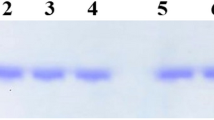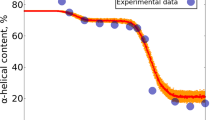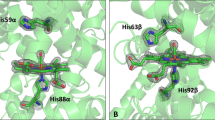Abstract
THIS article follows reports of the binding of xenon, an anaesthetic agent, to sperm whale met and deoxymyoglobin1,2. X-ray diffraction analysis showed that a single xenon atom binds to the same specific site in both derivatives. This site is located at a cavity in the interior of the molecule, about equidistant from the haem linked histidine and one of the pyrrole rings of the haem group. The difference electron density maps showed that there are no important changes in the structure of myoglobin, an observation which is also supported by the calculated approach distances. It is interesting to note that xenon with a van der Waals radius of 2.20 Å seems to be just large enough to fit into this cavity without disturbing the surrounding molecular arrangement. It has been found by spectroscopic analysis that this binding of xenon to myoglobin does not appreciably alter the oxygen affinity of myoglobin. Lumry (personal communication) demonstrated, however, that the carbon monoxide affinity of xenon–myoglobin is increased ten times compared with native myoglobin. It also should be noted that the much larger mercuri–iodide3 binds at the same place, but this time considerably distorting the surroundings. These results led to the present X-ray diffraction analysis of the binding of cyclopropane, which is slightly larger (0.2 Å, see Table 2) than xenon, to myoglobin. Crystals of sperm whale met myoglobin prepared by the method of Parrish and Kendrew4 were mounted in quartz capillaries and equilibrated with cyclopropane at a pressure of two atmospheres. X-ray intensities of the hk0 and h0l reflexions were collected to 2.8 Å resolution with multiple-film precession photographs. From such data, electron density difference maps between met myoglobin–cyclopropane and the native met myoglobin were calculated using the phase angles for the native structure (unpublished work of Kendrew et al.). Each of these difference electron density maps (Figs, 1a and b) shows a number of features. The positive peak 1 (x= 0.176, y= 0.845, z= 0.187) represents the cyclopropane addition to the molecule and corresponds to the site of the xenon position as found in met and deoxymyoglobin. The negative peak 2 corresponds to the site of a phenylalanine (H14) in the native structure. This negative peak indicates a reorientation of the benzene ring of the phenylalanine group, which is most likely rotated by approximately 90° along the Cα–Cβ bond into a position corresponding to the positive region 3. This reorientation of the phenylalanine ring necessitates some adjustments of neighbouring groups, particularly the two leucines H11 and H13. Possible interference of the displaced phenylalanine with the alanine H10 cannot be ruled out on the basis of the calculated difference maps; it seems, however, unlikely that the H helix would move. Such reorientations are indicated by secondary peaks in the difference maps (Figs, 1a and 1b). It should be noted that cyclopropane is such a light “heavy atom” that secondary sites of less than 35 per cent occupancy would not show up on these difference projections. The calculated approach distances from the centre of peak 1 (cyclopropane site) to the nearest atomic positions as found in the native structure are given in Table 1 and show that a number of approaches are considerably smaller than the sum of the relevant van der Waals radii (Table 2), indicating also reorientation of some amino-acid side chains. Cyclopropane is nearly equidistant from the haem linked histidine and a pyrrole ring of the haem group, groups which do not seem to have moved. Generally, it seems that cyclopropane is bound to myoglobin in the same manner as xenon and is stabilized mainly by London interactions, with some contributions from dipole-induced dipole and charge-induced dipole interactions. There is also an entropy gain, which arises from the cyclopropane transfer into the protein.
This is a preview of subscription content, access via your institution
Access options
Subscribe to this journal
Receive 51 print issues and online access
$199.00 per year
only $3.90 per issue
Buy this article
- Purchase on Springer Link
- Instant access to full article PDF
Prices may be subject to local taxes which are calculated during checkout
Similar content being viewed by others
References
Schoenborn, B. P., Watson, H. C., and Kendrew, J. C., Nature, 207, 28 (1965).
Schoenborn, B. P., and Nobbs, C. L., J. Mol. Pharmacol., 2, 491 (1966).
Kretsinger, R. H., Watson, H. C., and Kendrew, J. C., J. Mol. Biol. (in the press).
Parrish, R. G., and Kendrew, J. C., Proc. Roy. Soc., A, 238, 305 (1956).
Kendrew, J. C., Watson, H. C., Strandberg, B. E., Dickerson, R. E., Phillips, D. C., and Shore, V. C., Nature, 190, 666 (1961).
Author information
Authors and Affiliations
Rights and permissions
About this article
Cite this article
SCHOENBORN, B. Binding of Cyclopropane to Sperm Whale Myoglobin. Nature 214, 1120–1122 (1967). https://doi.org/10.1038/2141120a0
Received:
Issue Date:
DOI: https://doi.org/10.1038/2141120a0
This article is cited by
-
Intrinsic interaction mode of an inhalation anesthetic with globular proteins: a comparative study on ligand recognition
Colloid and Polymer Science (2011)
-
NMR identification of hydrophobic cavities with ow water occupancies in protein structures using small gas molecules
Nature Structural & Molecular Biology (1997)
-
Sites of alcohol and volatile anaesthetic action on GABAA and glycine receptors
Nature (1997)
Comments
By submitting a comment you agree to abide by our Terms and Community Guidelines. If you find something abusive or that does not comply with our terms or guidelines please flag it as inappropriate.



